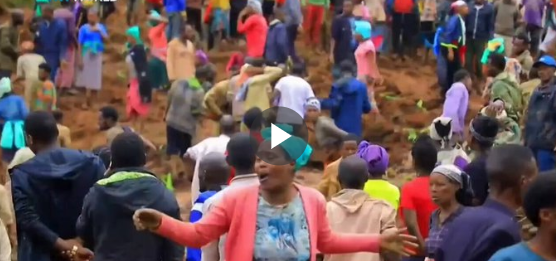The death toll from two catastrophic landslides in southern Ethiopia has skyrocketed to a staggering 157, with grim expectations that it might rise even further, a government official disclosed on Tuesday.
At least 157 people killed in mudslides in remote part of Ethiopia hit by heavy rainfall – many died as they tried to rescue survivors of an earlier mudslide, local authorities say pic.twitter.com/2KcygVRRws
— TRT World Now (@TRTWorldNow) July 23, 2024
In the Gofa zone of the Southern Ethiopia regional state, calamity struck twice. Initially, a monstrous landslide buried unsuspecting residents. Then, as if the heavens weren’t done with their cruel test, another landslide engulfed the courageous souls who had rushed to help the victims of the first disaster, turning the rescue mission into a desperate struggle for survival.
Markos Melese, head of the National Disaster Response agency in Gofa Zone, shared the harrowing details via phone, his voice heavy with the weight of the ongoing tragedy. “The search is relentless, but the terrain is merciless. There are still bodies hidden beneath the rubble,” he explained to Reuters. “So far, 157 bodies have been recovered from the wreckage of two villages… and we fear the toll will rise.”
The mudslides struck with deadly precision in the Kencho Shacha Gozdi district, claiming lives indiscriminately. Among the deceased are innocent children and expectant mothers, their futures cruelly snatched away. Local administrator Dagmawi Ayele recounted the heart-wrenching losses with a somber tone.
Ethiopia’s rainy season, commencing in July and persisting until mid-September, notoriously brings landslides, especially in susceptible regions. Torrential downpours saturate the earth, setting the stage for such devastating events. The recent disaster highlights the peril that lurks during these months.
Around 157 people have been killed due to a mudslide in Ethiopia. pic.twitter.com/SxAZN9cWTW
— Ahmed Ibrahim Gaandaa (@AhmedGaandaa) July 23, 2024
Communities in southern Ethiopia are now grappling with the aftermath of this double tragedy. The response teams, despite their relentless efforts, are up against formidable odds. The relentless rain, treacherous mud, and unstable ground have turned rescue operations into a perilous endeavor. Local resources are stretched thin, and the urgent call for additional support and specialized equipment grows louder.
Survivors, shattered by the loss of loved ones and the destruction of their homes, face an uncertain future. The psychological scars, especially among children who witnessed the chaos, are profound. Addressing mental health needs is becoming an essential part of the ongoing relief efforts.
As rescue operations press on, there is a concurrent push for preventive strategies to avert such tragedies in the future. Enhancing early warning systems, bolstering infrastructure resilience, and implementing sustainable solutions are critical. The government and local authorities are under immense pressure to act swiftly and decisively.
At least 157 people were killed in mudslides in a remote part of Ethiopia that has been hit with heavy rainfall, many of them as they tried to rescue survivors of an earlier mudslide, local authorities said Tuesday.
Read more:https://t.co/qetrxCNqFI pic.twitter.com/vRstOWHzCc
— CNC3TV (@CNC3TV) July 23, 2024
The Gofa zone landslides serve as a stark, devastating reminder of nature’s unpredictability and the urgent need for preparedness. As the search for survivors continues, the spotlight shines brightly on the necessity for a coordinated, well-resourced response to mitigate the impact of future disasters.
Major Points:
- Two deadly landslides in southern Ethiopia’s Gofa zone have resulted in 157 deaths, with the toll expected to rise.
- A second landslide struck rescuers aiding victims of the first disaster, exacerbating the tragedy.
- Victims include children and pregnant women, underscoring the widespread impact of the mudslides.
- Ethiopia’s rainy season, from July to mid-September, heightens the risk of such natural disasters.
- Ongoing rescue efforts face immense challenges due to difficult terrain and adverse weather conditions, emphasizing the need for better preventive measures.
RM Tomi – Reprinted with permission of Whatfinger News



